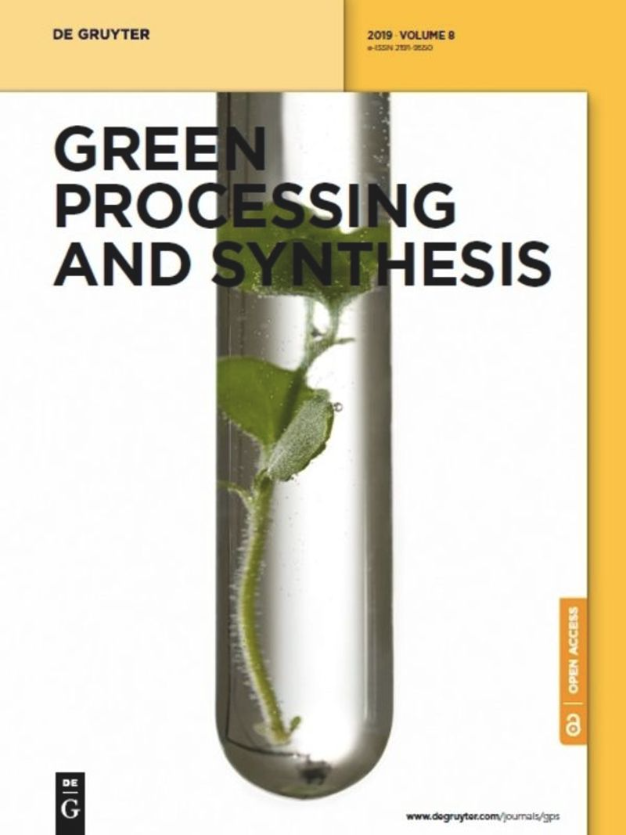由珊瑚介导的纳米金属和壳聚糖纳米颗粒组成的抗鱼源性病原体的强大抗菌纳米复合材料
IF 3
4区 工程技术
Q2 CHEMISTRY, MULTIDISCIPLINARY
引用次数: 0
摘要
摘要鱼源性人畜共患细菌可能对人类构成威胁;纳米生物技术可以作为对抗它们的有效解决方案。使用珊瑚提取物(CoE)实现了金属纳米颗粒(NP)、银(AgNP)和硒(SeNP)的直接藻合成。还完成了由藻合成的NP和纳米壳聚糖(NCht)构建纳米复合材料(NCs),以评估这些完整的化合物/NCs作为抗鱼传细菌、嗜水气单胞菌、铜绿假单胞菌、鼠伤寒沙门氏菌和金黄色葡萄球菌的抗菌汞合金。对整个制剂/NCs进行了表征和评估。使用红外分析确定了化学品和NCs的结构和相互作用。CoE/AgNP、CoE/SeNP、NCht、NCht/CoE/AgNP和NCht/CoE/SeNP的平均颗粒直径分别为5.52、12.46、59.81、64.59和77.16 nm,通过尺寸研究和电子显微镜证实了这一点。使用定性和定量分析,受攻击的细菌对所检查的试剂完全敏感;金黄色葡萄球菌的耐药性更强,而嗜水气单胞菌是最敏感的菌株。NCs(NCht/CoE/AgNPs和NCht/CoE/SeNPs)分别具有最大的杀菌潜力;它们超过了氨苄青霉素的作用。通过扫描成像在10 暴露小时。CoE介导的NP与NCht的结合产生了有效和无害的NCs,适用于去除具有生物安全特性的鱼传病原体。本文章由计算机程序翻译,如有差异,请以英文原文为准。
Powerful antibacterial nanocomposites from Corallina officinalis-mediated nanometals and chitosan nanoparticles against fish-borne pathogens
Abstract The fish-borne zoonotic bacteria may pose a risk to humans; nanobiotechnological techniques could serve as effective solutions for fighting them. The direct phycosynthesis of metals’ nanoparticles (NPs), silver (AgNPs), and selenium (SeNPs) using Corallina officinalis extract (CoE) was achieved. The construction of nanocomposites (NCs) from phycosynthesized NPs and nano-chitosan (NCht) was also accomplished to evaluate these entire compounds/NCs as antibacterial amalgams against fish-borne bacteria, Aeromonas hydrophila, Pseudomonas aeruginosa, Salmonella typhimurium, and Staphylococcus aureus. The entire agents/NCs were characterized and assessed. The structure and interactions of chemicals and NCs were determined using infrared analysis. CoE/AgNPs, CoE/SeNPs, NCht, NCht/CoE/AgNPs, and NCht/CoE/SeNPs had mean particles’ diameter of 5.52, 12.46, 59.81, 64.59, and 77.16 nm, respectively, which were confirmed by size studies and electron microscopy. The challenged bacteria were entirely susceptible to the inspected agents, using both qualitative and quantitative assays; S. aureus was more resistant, while A. hydrophila was the most sensitive strain. The NCs (NCht/CoE/AgNPs and NCht/CoE/SeNPs) have the utmost bactericidal potentialities, respectively; they exceeded the action of ampicillin. The total distortion, disintegration, and lysis of the treated A. hydrophila cells were highlighted by scanning imaging within 10 h of exposure. The conjugation of CoE-mediated NPs with NCht produced effective and harmless NCs, valid for applications to remove fish-borne pathogens with biosafe characteristics.
求助全文
通过发布文献求助,成功后即可免费获取论文全文。
去求助
来源期刊

Green Processing and Synthesis
CHEMISTRY, MULTIDISCIPLINARY-ENGINEERING, CHEMICAL
CiteScore
6.70
自引率
9.30%
发文量
78
审稿时长
7 weeks
期刊介绍:
Green Processing and Synthesis is a bimonthly, peer-reviewed journal that provides up-to-date research both on fundamental as well as applied aspects of innovative green process development and chemical synthesis, giving an appropriate share to industrial views. The contributions are cutting edge, high-impact, authoritative, and provide both pros and cons of potential technologies. Green Processing and Synthesis provides a platform for scientists and engineers, especially chemists and chemical engineers, but is also open for interdisciplinary research from other areas such as physics, materials science, or catalysis.
 求助内容:
求助内容: 应助结果提醒方式:
应助结果提醒方式:


